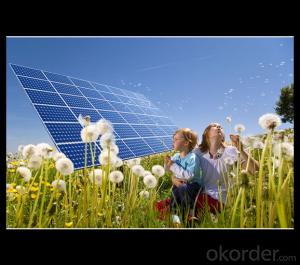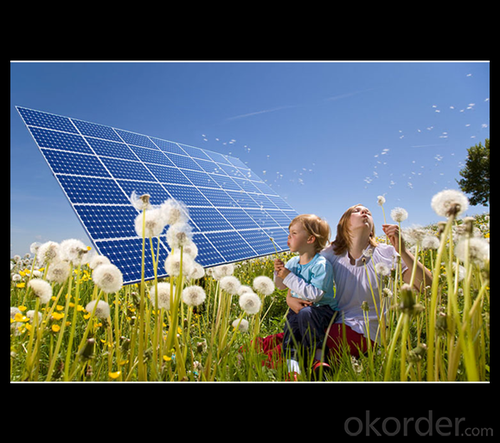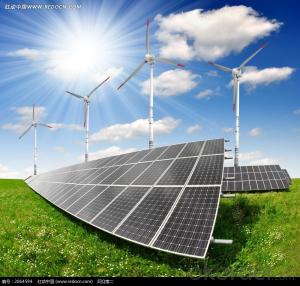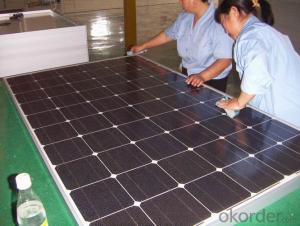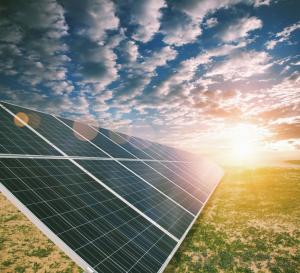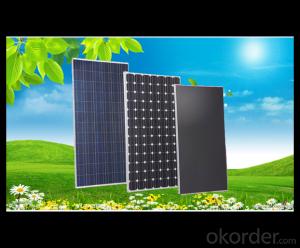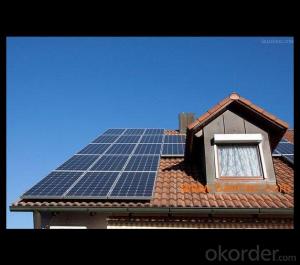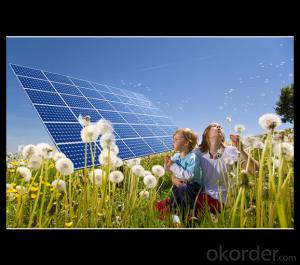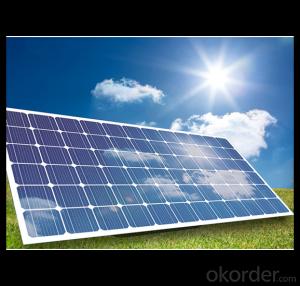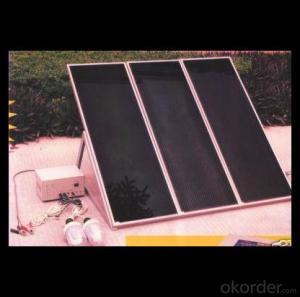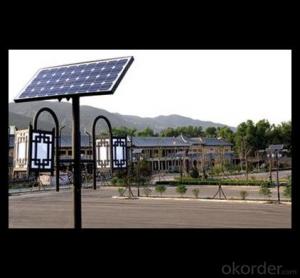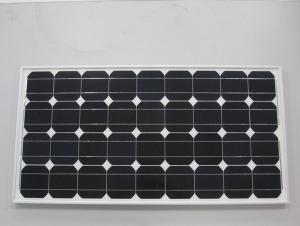Sunlight Solar Panels - 240w Direct Factory Sale Price 240-255watt Solar Panels
- Loading Port:
- China main port
- Payment Terms:
- TT OR LC
- Min Order Qty:
- 10000 watt
- Supply Capability:
- 100000 watt/month
OKorder Service Pledge
OKorder Financial Service
You Might Also Like
Specification
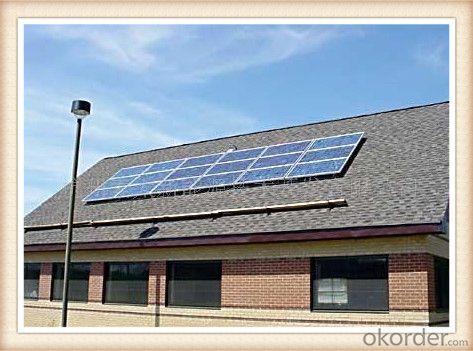
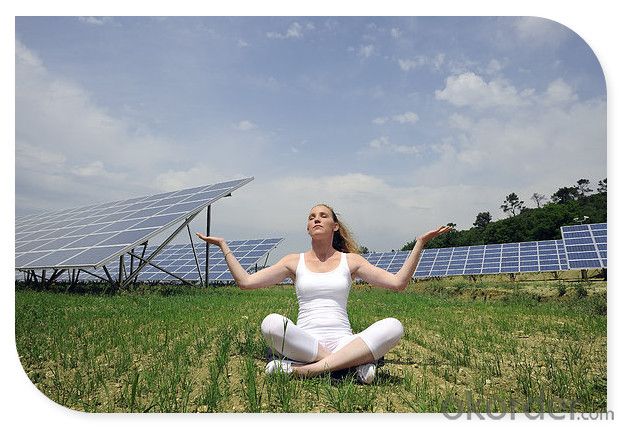
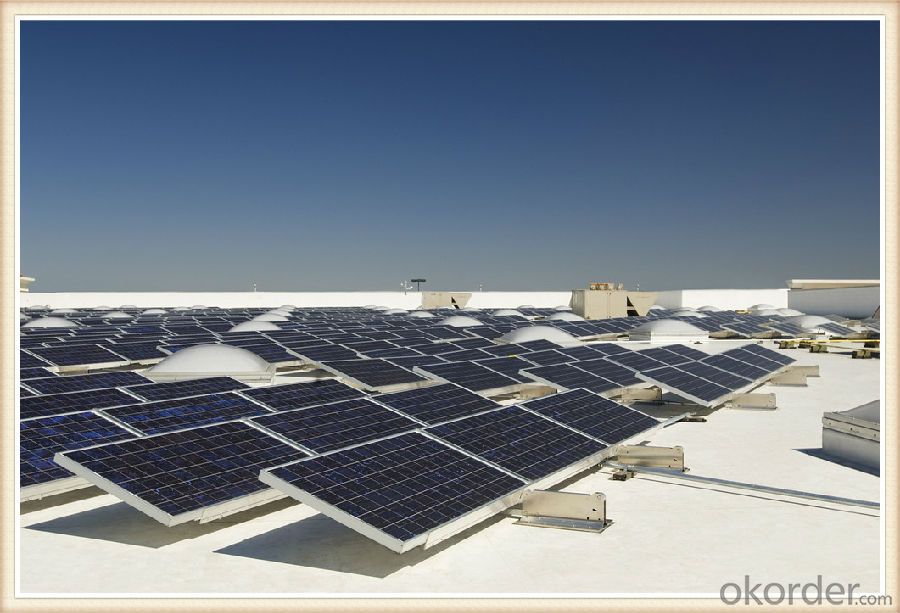
Solar Module Introduction
Solar modules use light energy (photons) from the sun to generate electricity through the photovoltaic effect. The majority of modules use wafer-based crystalline silicon cells or thin-film cells based on cadmium telluride or silicon. The structural (load carrying) member of a module can either be the top layer or the back layer. Cells must also be protected from mechanical damage and moisture. Most solar modules are rigid, but semi-flexible ones are available, based on thin-film cells. These early solar modules were first used in space in 1958.
Electrical connections are made in series to achieve a desired output voltage and/or in parallel to provide a desired current capability. The conducting wires that take the current off the modules may contain silver, copper or other non-magnetic conductive transition metals. The cells must be connected electrically to one another and to the rest of the system. Externally, popular terrestrial usage photovoltaic modules use MC3 (older) or MC4 connectors to facilitate easy weatherproof connections to the rest of the system.
Specification
Model Type | |
Peak Power-Pmax(W) | 5-200W |
Open Circuit Voltage-Voc(V) | 44.2 |
Maximum Power Voltage-Vmp(V) | 36 |
Short Circuit Current-Isc(A) | 5.4 |
Maximum Power Current-Imp(A) | 5 |
Maximum System Voltage | 1000V DC |
Maximum Series Fuse Rating | 10A |
Power Tolerance | -1~+3% |
Temperature Coefficients of Pmax | -0.45%/℃ |
Temperature Coefficients of Voc | -0.348%/℃ |
Temperature Coefficients of Isc | 0.031%/℃ |
Nominal Operating Cell Temperature | 44.5±2℃ |
Standard Testing Condition(STC) | Irradiance:1000W/m²;Temperature:25℃;AM=1.5 |
Qualification Test Parameters | |
Operating Temperature | -40℃~+85℃ |
Storage Temperature | -40℃~+85℃ |
Pressure Bearing | ≥5400Pascal/m² |
Wind Bearing | ≥5400Pascal/m² |
Mechanical Characteristics | |
Cell Size | Mono 125*125mm±0.5 |
No.of Cells | 72pcs(6*12) |
Dimension | 1580*808*40mm |
Weight | 15.5Kg |
Glass | 3.2mm High Transmission,Low Iron |
Frame | Anodized Aluminum Alloy |
Junction Box | IP65Rated |
Internal Diodes | 3 Bypass Diodes |
Cable | 1*4.0mm² Length 900mm |
Images
Packing & Shipping:
We have rich experience on how to pack the panels to make sure the safety on shipment when it arrives at the destination.
The normal size is packed by 25pcs/ carton / pallet. Paper carton for FCL shipping and wood carton for LCL shipping.
Features
1.High reliability with guaranteed -3% to +5% power output tolerance, ensuring return on investment
2.High conversion efficiency based on leading innovative photovoltaic technologies
3.Withstands high wind-pressure and snow load, and extreme temperature variations
4.Attractive appearanceUnique frame design, high mechanical strength, and easy Installation
Warranty:
For c-Si panel: 25years output warranty for no less than 80% of performance, 10 years output warranty for no less than 90% of performance. Free from material and workmanship defects within 5 years.
For a-Si panel: 20 years output warranty for no less than 80% of performance, 10 years output warranty for no less than 90% of performance. Free from material and workmanship defects within 2 years.
•100% product quality protection
•100% on-time shipment protection
•100% payment protection for your covered amount
FAQ:
(1)What price for each watt?
It depends on the quantity, delivery date and payment terms.
(2)What is your size for each module? Can you tell me the Parameter of your module?
We have different series of panels in different output, both c-Si and a-Si. Please take the specification sheet for your reference.
(3)Can you provide the peripheral products of the solar panels, such as the battery, controller, and inverter? If so, can you tell me how do they match each other?
Actually we are only manufacturer of solar panels, but we could try to source them for you in China if you need. We could provide you an optimal system design to instruct you how to install.
(4)Do you have the CE, TUV, UL Certification?
We’ve already passed all the tests, and any certificate is available.
(5)Have you ever sold your products to companies in my country?
Of course, we have customers in all general PV markets, but I think we should expand our market share along with the market growth.
(6)When did your company set up? You are a new company, how can I believe your quality?
We entered into Solar PV industry in 2005, now we have several plants in manufacturing of a-Si and c-Si panels, and our capacity is 220MW per year. Till now we have already passed all the tests by authorized laboratories, e.g. TUV, VDE, UL.
(7)Can you help us install the module if we cooperate with you?
We haven’t entered into installation sector, but we have the plan in near future.
(8) How do you pack your products?
We have rich experience on how to pack the panels to make sure the safety on shipment when it arrives at the destination.
(9) Can you do OEM for us?
Yes, we can.
(10)Can we visit your factory?
Surely, I will arrange the trip basing on your business schedule.
- Q: Why would someone use a solar panel? Does it have to do with the economy right now, global warming, or what?
- I doubt the immediate economy has much to do with it. Solar panels require long-term investment, so in hard times, someone having trouble making ends meet is not going to be buying solar panels, when they could be buying food. It's like if someone has a gas guzzler, if they get laid off, they're not going to spend their savings on a new, fuel efficient car, even if it saves money in the long term. However, it's generally the more wealthy that install solar, and they're not impacted as much by a slow economy. Human nature being what it is, I doubt many people install solar to save the planet. There will be some, but I suspect most are interested in the long-term financial savings. I'm kind of unusual, in that our panels are break-even financially at best. The main reason I put them up was for the fun of learning and doing it.
- Q: What is the average payback period for solar panels?
- The average payback period for solar panels typically ranges from 5 to 10 years, depending on various factors such as the initial cost of installation, local electricity rates, available incentives, and the amount of sunlight received in the area.
- Q: Didnt solar panels use to cost around $250,000 5 years ago?
- For just 5 years ago, certainly not! Perhaps you are thinking of 50 years ago, the kind that was put on the early communication satellites? 5 years ago, there was a glut of polysilicon, so modules were actually a little cheaper than today. Solar cell makers were basically using the scraps thrown away by chipmakers. But today, more silicon goes into making solar cells than computer chips, so that bonanza is gone. We will see prices going lower this year, possibly 20% from last year, because of improvements in technology, but also an increase in polysilicon supply, and a slowdown in demand due to worldwide recession. Later this year is a good time to buy panels, if you have the cash. The industry site below tracks module prices. They used to have more data, but I guess the old data rolls off the screen with time. If you want to see the details, they'll charge you for the report.
- Q: Given that I am going to purchase a solar panel to charge my cell phones and other gadgets, I would like to know what the ammount of power produced by a 6 Watt solar panel is under regular circumstances. (IE partial sun, full sun, cloudy)
- That site tells you somewhat about the cost of solar panels and their MAXIMUM output. Now some who have these panels claim output, in daily terms, 8 times as great as maximum output, which says they are counting on 8 hours of effective sunlight. In California Desert that is sound. You will discover that Ontario Power grid is planning for 3 hours to 4 hours of maximum output . Based on that 3 to 4 hours of maximum output, it would take close to 20 years to recover your cost at the price Ontario pays for solar power. The deal locks you in so that you can not get more money as electricity prices go up, and do not lose if electricity prices go down over that 20 years.
- Q: can a small solar panel be charged with lamps?
- That would depend on the frequency that the solar panel accepts and the frequency of light that your lamp gives out. It may or may not work. The sun gives out a much broader spectrum of light, which is why solar panels are much more effective in sunlight. I have seen solar panels charged by lamps, but it usually doesn't work that well and I have never seen it work with fluorescent lighting.
- Q: I had installed over the summer a solar panel system on my house. Hers some infofor you: I live in MOThe system cost 25K (Rounded numbers)The Rebate from the utility company was about 0KThe expected tax rebate will be about 5KI have a home office from which I work and is 5% of my homes sq footage. My question is though I am getting a basic tax rebate, should I be able to claim part of this off as an expense for my home office?It seams logical since I used to deduct part of my electric bill and I there for should be able to write off part of this. I am, after all using electricity and getting a bill from the utility that is higher than it would be if I didn't have the office2. If so which amount should it be? The full 25K or something after the rebates.
- Pretty much stop existing.. Global Warming is Earth's way of pretty much saying..NEXT...We arent causing global warning its time for a change and the earth is doing it.. Mt St helens and also Mt Pinatubo put out more green house gases than anything humans did in history ..Its just a normal trend..Getting ready for the coming of another species.. just like it did with us and we survived ..that should be the question here ,how to survive the earths changes not what we can do about it. There is nothing we can do that will make a difference..Told Decaprio the same thing..
- Q: A homeowner is considering putting a horizontal solar panel on her roof to heat water for domestic use. An average increase of water temperature each day from 60oF to 20oF is wanted for 50 gallons. How large a panel would be needed on a clear winter day at 40o latitude if the overall efficiency is 50%?
- Here's a typical 4' x 8' collector rating. 40 degree latitude would be a cool climate, so you look at row D, water heating in a cool climate. Probably take the middle rating, mildly sunny day, and it is 0,000BTU per panel per day (it's 9,000 on a sunny day). 38,700 BTU / 0,000 BTU = 3.87, they'd need about 3 to 4 panels. If you used the sunny day number, you'd only need 2, but 3 is more realistic, as it is not always a sunny day.
- Q: How do solar panels affect the energy independence of a building?
- Solar panels can greatly enhance the energy independence of a building by converting sunlight into electricity. By generating their own clean and renewable energy, buildings with solar panels can reduce their reliance on traditional energy sources such as fossil fuels or the power grid. This not only decreases the building's carbon footprint and environmental impact but also provides a more reliable and sustainable source of energy, ultimately leading to greater energy independence.
- Q: I can't figure out how to charge a Ni Cd (BD 8V Firestorm) battery directly with a solar panel so I've come up with an alternative which might or might not work. I thought I would connect an inverter (I found a nice 400W for $30) to my trucks battery and plug the BD Firestorm battery charger into the inverter. Then I was thinking I could use a 5W solar panel to trickle charge the truck battery and keep it connected after the Ni Cd is charged to ensure the truck battery is topped off. The truck would not be running during this process. Will this solution work? Is there a better solution?
- Two of those solar panels connected in series will easily charge a 8V battery. I would not even be concerned about over voltage the solar cells will have plenty of internal resistance.
- Q: What happens to solar panels during extreme weather conditions?
- During extreme weather conditions, such as hurricanes or heavy snowstorms, solar panels can be damaged or temporarily rendered ineffective. Strong winds, flying debris, or heavy snow can cause physical damage to the panels, such as broken glass or dislodged components. Additionally, excessive snow accumulation can cover the panels, reducing their ability to generate electricity. However, modern solar panels are designed to withstand most extreme weather conditions and are tested to meet certain durability standards.
Send your message to us
Sunlight Solar Panels - 240w Direct Factory Sale Price 240-255watt Solar Panels
- Loading Port:
- China main port
- Payment Terms:
- TT OR LC
- Min Order Qty:
- 10000 watt
- Supply Capability:
- 100000 watt/month
OKorder Service Pledge
OKorder Financial Service
Similar products
Hot products
Hot Searches
Related keywords
